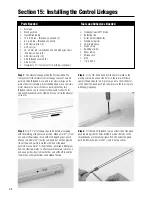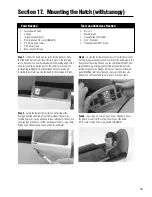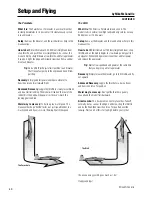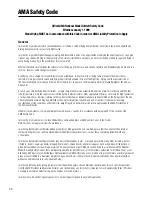
47
The Waterfall
What it is:
This maneuver is a continuous tail-over-nose
descending flip. It is not a loop, but the aircraft actually flops
around its canopy.
Setup:
Again, the critical component is having the 3-D elevator.
The aft CG helps this the most.
How it’s done:
Start relatively high. At low throttle, gradually
pull the nose up until its near vertical. Just before it stalls, add
full down and, at the same time, add full power. You have to
continuously “fly” the rudder and ailerons to keep the model
flipping over in a straight line. To do consecutive Waterfalls,
continue to hold full down and to “fly” rudder and ailerons and
chop the throttle as the nose comes back up to vertical, then add
full power as it flips straight down.
Trickiest part:
No doubt here—flying the rudder and aileron
correctly. You have to fly the rudder and ailerons and make
constant corrections. The amount you add will vary. If you do not
do this, the model will fall off into a knife edge spin.
Recovery:
Just neutralize the elevator and the Edge will quit
flipping, but expect some over-rotation, so practice high until
you get the feel of it. Fly out straight and level or stop the rotation
while pointed vertical and go into a Torque Roll.
Worst way to mess up:
Take it down too low, over-control
your elevator on recovery, and snap into the ground. To avoid
this, simply change rates on your elevator to normal travel.
The Torque Roll
What it is:
The Edge “hovers” vertically in place, rotating left
around its roll axis. The “in-line” midwing configuration of the
Edge makes it one of the easiest Torque rollers around.
Setup:
Full 3-D throws in elevator and rudder are a must. An aft
CG helps a little. Also gyros provide the best aid to stabilize the
aircraft. They won’t do the maneuver for you but they’ll help. I
found them a fantastic tool in learning to torque roll, kinda like
training wheels. A few years ago gyros made a big difference for
me; now I don’t use them anymore. You’ll need a power plant
that will give you unlimited vertical before you try this one.
How it’s done:
Fly low along the ground at low throttle and
gently add power with up elevator to bring the model into a
vertical position. Add throttle to keep the nose pointed up and
make corrections with rudder and elevator to keep things
straight. If the model hovers but won’t start rolling left, quickly
blip the throttle up and down. The torque change will usually get
it going.
Trickiest part:
Recognizing your correction when the model’s
belly is toward you.
Tip:
Think push the rudder toward the low wing when the
belly is toward you. You have to be fast with throttle
corrections. Add bursts of power, along with
rudder/elevator corrections. If you simply hold full
throttle, you’ll climb out of the maneuver.
Recovery:
Fly out at full throttle.
Worst way to mess up:
Have an unreliable engine. Torque
Rolls are tough on engines because there’s only prop-induced
airflow over the cylinders. I’d really recommend putting the
baffling in the cowl if you are running a twin-cylinder engine and
plan on doing Torque Rolls.
Setup and Flying
CONTINUED
by Mike McConville
The Torque Roll
The Waterfall
Содержание EDGE 540
Страница 52: ...52 ...
Страница 53: ...53 Template Cut Out of Cowl Bottom MDS 1 48 ...
Страница 54: ...54 ...
Страница 55: ...55 ...
Страница 56: ... 2000 Horizon Hobby Inc www horizonhobby com ...
Страница 57: ...57 ...
Страница 58: ...58 ...
Страница 59: ...59 ...













































